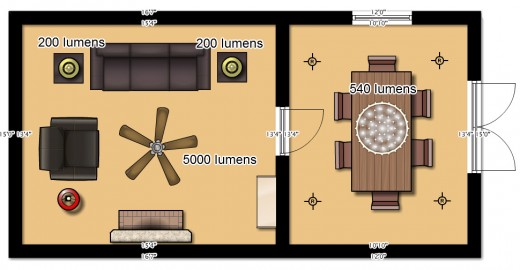How Many Lumens Do I Need?
Updated 10/16/23 by Angela Rogers
In recent years, household incandescent light bulbs have given way to new, sometimes unfamiliar technologies. If you shop for light bulbs in a store today, you may find a couple “full spectrum” incandescents or halogen floodlights, but other than those, compact fluorescent and LED bulbs line the shelves. Long gone are the days of throwing your favorite brand of 60-watt light bulb in your cart and being on your way. No, you may not even be sure which funny-looking 60-watt equal light bulb you need.
Lumens vs Watts: The Great Debate
Many people mistakenly assume that they need to look solely at wattage when buying replacements for incandescent bulbs. If you are buying another incandescent bulb, which is getting harder to find these days, then looking at just the wattage is fine. This is because incandescent bulbs' brightness is base on its wattage. The higher the wattage, the brighter the bulb.
However, if you opt to upgrade to newer lighting technology such as LED light bulbs, you'll need to get rid of any notions you have about wattage or incandescent equivalencies. In many cases, choosing an LED bulb based solely on the stated wattage equivalent will leave you with a bulb that is nowhere near as bright as the one it's replacing. Or, other times, you may end up with a bulb that's so bright that it practically blinds you.
Why is this? It's because the brightness of LED lights is determined by lumens, not wattage.
What are Lumens?
So, what are lumens? If you read our previous article on lumens, candlepower and CRI, you may remember the definition of lumens. If not, here's the gist: "Lumens…represent the actual amount of ambient light coming from a lamp. The higher the lumens, the more ‘lit up' a room will be."
Why does this affect Wattage Equivalencies?
Because there is no agreed-upon standard among manufacturers for determining equivalent wattages, statements of incandescent equivalency for CFL and LED bulbs are not always dependable. So to determine the amount of light you need in your home, stop thinking about watts and start thinking about lumens.
Wondering how to calculate the lumens of your incandescent bulb? Check out From Watts to Lumens: Choosing Lights Based on Brightness.
Where do I find lumen information?
Finding out how many lumens an LED bulb produces is fairly easy. Most manufactures display lumen amounts on the front of the packaging where it is easy to see. You can also find it included as part of the Lighting Facts label as well. These labels are usually located on the back or sides of the box. For example, take a look at the box art below for a Euri LED A19 bulb. The locations with lumen information have been circled.
Box art for Euri Lighting bulb with lumens circled.
You can also find the lumens on the product pages. On 1000Bulbs.com, most product pages will display the lumen amounts into two spots: at the top of the page and in the Product Attributes section further down as shown in the image below.
Product page for Euri Lighting bulb with lumen amounts circled.
How Much Light Do I Need for a Room?
While that above definition of lumens is helpful, you're probably asking, “So, exactly what number of lumens do I need to light up my room?” The answer will vary based on the design and color scheme of your room, but here is good rule of thumb, loosely based on the IESNA Lighting Handbook:
Floors: 20 Lumens per Square Foot
Tables and Raised Surfaces: 30 Lumens per Square Foot
Desks and Task Lighting: 50 Lumens per Square Foot
Incandescent, CFL, or LED Lights: Which Bulb and How Many?
Determining which bulb type you would like and which ones to purchase to ensure a sufficient amount of light depends heavily on the square footage and purpose of the room. For the average living room of 250 square feet, you'll need 5,000 lumens as your primary light source (20 lumens x 250 square feet), equivalent to about five 100 watt incandescent light bulbs, five 23 watt CFLs, or eight 10 watt LED bulbs.
If you read on your couch and need more light output in that area, you'll need about 4 square feet of task lighting on each end of the couch. That's 200 lumens each (50 lumens x 4 square feet). However, if the light fixture is a lamp with a shade, you'll need a bit more.
In your dining room, you'll want about 30 lumens per square foot on your dining table (you want enough light output to see your food, but not examine it), so if your table is 6 x 3 feet, that's 540 lumens.
Keep in mind, however, that these numbers are simply a for rough estimate for typical conditions. If you have especially dark walls and furniture, you'll a higher number of lumens to properly light the space. The distance of your light source from the surface also changes the equation. We based our calculations on 8-foot ceilings and average height task lamps.
Finally, personal preference will play the largest part in your decision. If you like the room to be especially bright, you may want to add 10 to 20% to our numbers. In fact, the best idea for any home may be to aim a bit high on the total lumens needed and install dimmers so you can adjust the light emitted to your ideal level.
Have More Questions about Lumens vs Watts?
If you are having trouble determining how many lumens you need for your room or need helping finding the right light bulb, give us a call at 1-800-624-4488. Our expert team of US-based lighting specialists are ready to help. You can also visit our website at 1000Bubls.com.








![How to Repair a Table Lamp [Video]](https://images.squarespace-cdn.com/content/v1/56feae0ab6aa60ebb6039bf3/1614706440870-KEAU6MXE9XZW22L476MV/How+to+Repair+a+Table+Lamp.jpg)


